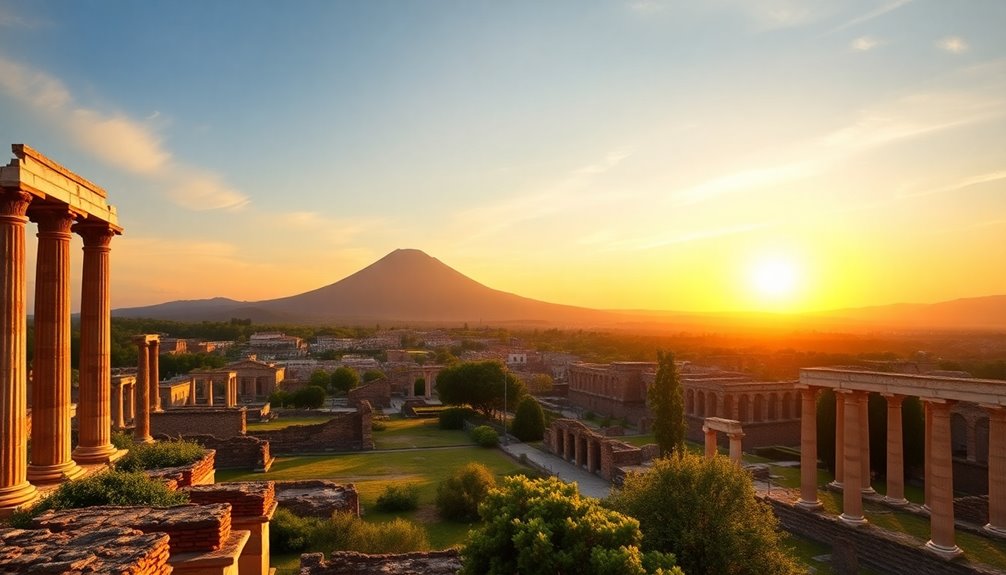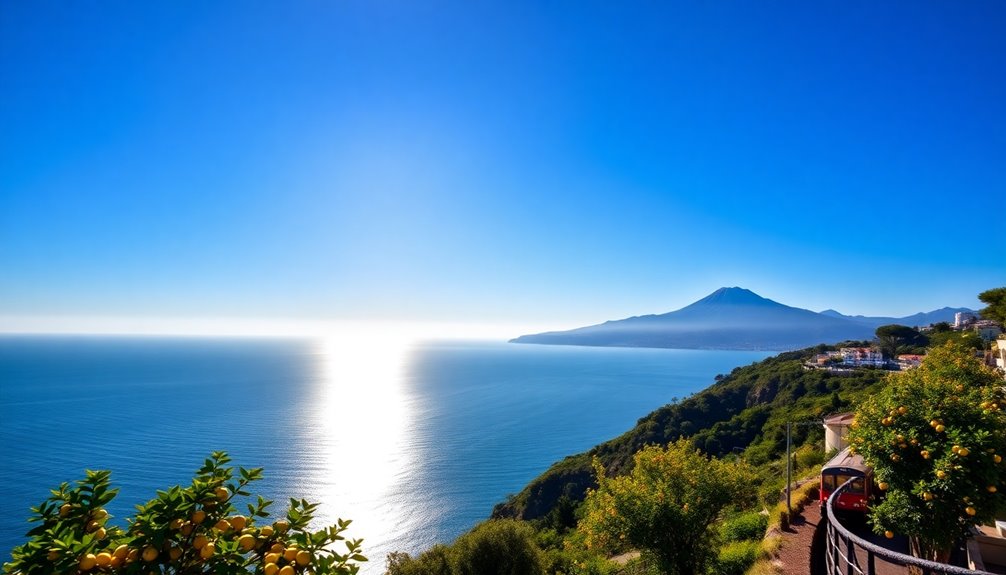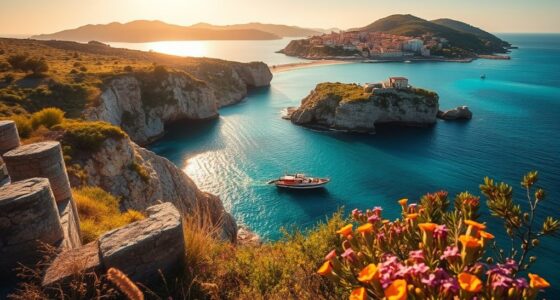Visiting Pompeii, Herculaneum, and Mount Vesuvius from Sorrento's a fantastic adventure. You can easily reach Pompeii via a quick train ride or bus, both eco-friendly choices. Once at Herculaneum, it's just a short walk from the station. Explore the well-preserved ruins and then prepare for an exhilarating hike up Mount Vesuvius. The views from the summit are breathtaking! Make sure to book tickets online to save time, especially during peak season. Remember to wear comfortable shoes and stay hydrated. If you want more tips and details about each site, there's plenty more to discover.
Key Takeaways
- Take the Circumvesuviana train from Sorrento to Ercolano for Herculaneum, approximately a 40-minute ride.
- Use public transport options like the bus or train to reach Pompeii, balancing cost with efficiency.
- Herculaneum's smaller size allows for a quicker visit, while Pompeii requires a full day to explore.
- Consider hiking Mount Vesuvius for stunning views; shuttles are available to the trailhead.
- Purchase tickets online in advance for Pompeii, Herculaneum, and Vesuvius to avoid long queues.
Getting to Pompeii

Wondering how to get to Pompeii from Sorrento? You've got a few good options, depending on your preferences for speed and cost.
The bus is a solid choice, covering the 17-mile distance in about 55 minutes. With a fare ranging from $2.99 to $8, it's both affordable and comfortable, featuring free Wi-Fi, power outlets, toilets, and comfy seats. Just keep in mind it runs only once daily. Additionally, the bus service is known for its eco-friendly travel option, which makes it a responsible choice for the environment. Many travelers choose this option for its lightweight design and convenience. Moreover, using public transportation can help reduce your carbon footprint.
If you're looking for a faster option, consider taking the train. The train covers a shorter distance of 12 miles and gets you there in about 41 minutes, including transfers. It runs hourly and costs between $3 and $5, making it the cheapest option. The train is the best combination of price and speed for travel.
For a quicker ride, you could grab a taxi or drive. Both options take around 33 minutes to cover the 15.6 miles, but be prepared to spend between $100 and $130 for a taxi. If you decide to drive, expect costs of about $5 to $7 for fuel and tolls.
You can book your bus or train tickets online through platforms like FlixBus or Omio for convenience.
Reaching Herculaneum
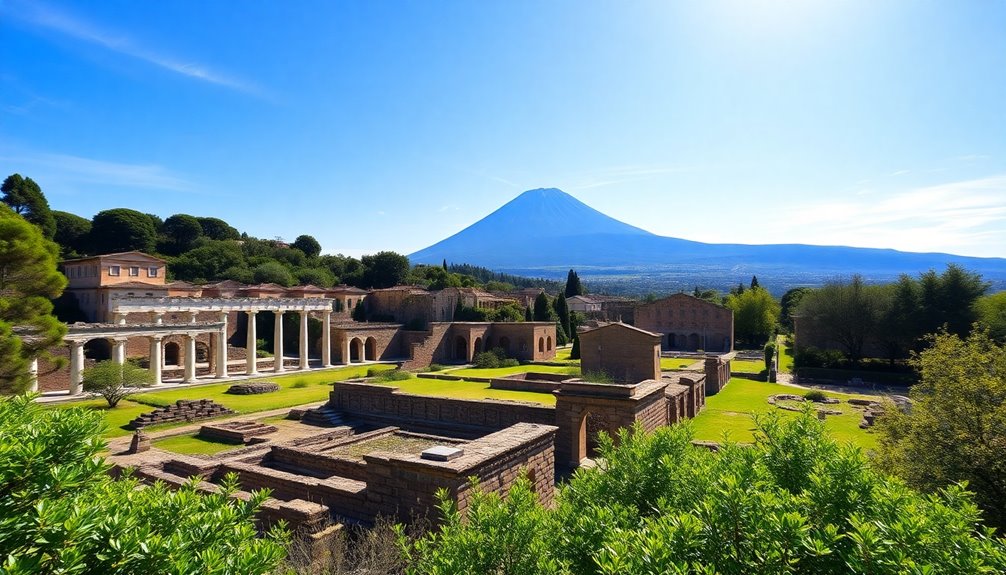
After exploring Pompeii, you might want to visit Herculaneum, another fascinating archaeological site nearby.
Getting there's quite straightforward. The easiest way is to take the Circumvesuviana train from Sorrento train station. Your journey will take about 40 minutes, and you'll get off at Ercolano station, which is just a 6-minute walk from the Herculaneum ruins. Herculaneum is located at the foot of Mount Vesuvius, making it an ideal stop after visiting Pompeii. The site offers a unique opportunity to walk through ancient Roman streets that have been remarkably preserved. Herculaneum was once a vibrant town, similar to Pompeii, and it provides insights into Roman life.
If you prefer a more comfortable experience, consider hiring a private driver. This option typically takes about an hour and is included in some half-day private tours from Sorrento. It's perfect for families traveling with kids and features professional, English-speaking drivers in air-conditioned vehicles.
While you could also take a bus, it's less direct. You'd need to take a bus shuttle to Piazza Garibaldi and then transfer to the Circumvesuviana train.
Once you arrive at Ercolano Scavi train station, simply walk downhill about 500 meters to the entrance.
Don't forget to bring suncream and sunhats during the summer, as there's limited shade.
Exploring Mount Vesuvius
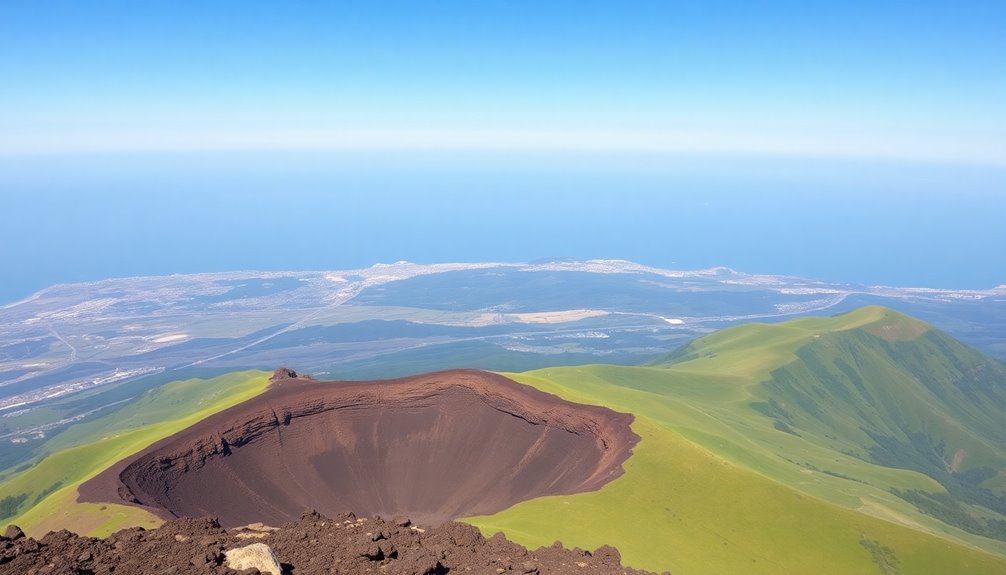
Standing at the base of Mount Vesuvius, you can't help but feel a mix of awe and respect for this mighty volcano that shaped the landscape and history of the region. Rising 1,281 meters (4,203 feet) above sea level, its towering cone dominates the skyline, partially encircled by the steep rim of Mount Somma.
As you explore the area, you'll realize that Vesuvius isn't just beautiful; it's one of the most dangerous volcanoes in the world. With over 3 million people living nearby, the threat of explosive eruptions looms large. The catastrophic eruption of 79 AD destroyed Pompeii and Herculaneum, claiming thousands of lives. Since then, Vesuvius has erupted more than 50 times, with its last activity occurring in March 1944. This volcano is classified as a somma–stratovolcano, which results in its distinct cone shape and steep summit. Interestingly, the word "volcano" originated from the Roman God Vulcan after the eruption in AD 79.
Despite its risks, the slopes are rich in vegetation and agriculture, offering breathtaking views and a glimpse into the fertile plains below. As you hike the trails, you're walking through a landscape shaped by fire and history, reminding you of the volcanic power that lies beneath.
Don't forget to take in the panoramic views from the summit—it's an experience you won't soon forget.
Comparing Pompeii and Herculaneum

When you think about the ancient towns affected by Mount Vesuvius, Pompeii and Herculaneum stand out as two of the most significant archaeological sites.
Pompeii is much larger, covering around 170 acres, and requires a full day or more to explore thoroughly. In contrast, Herculaneum is smaller and more compact, allowing you to see its highlights in just a few hours.
Preservation is another key difference. Herculaneum boasts better-preserved ruins due to a 25-meter layer of volcanic ash and molten rock, protecting its houses and even organic materials like wood and food. This preservation allows visitors to witness the intricate details of Roman artistry in its frescoes and mosaics. Additionally, Herculaneum features unique wooden structures that showcase advanced Roman engineering.
Pompeii, while famous for its plaster casts of human bodies, has suffered from weather and earlier excavations, leaving only lower walls intact.
Historically, Pompeii is more renowned, attracting larger crowds, while Herculaneum offers a more intimate experience with fewer visitors.
Herculaneum's rich architecture reveals insights into ancient private life, featuring exquisite mosaics and frescoes, along with the discovery of over 1,700 carbonized papyrus scrolls.
Ultimately, both sites provide unique glimpses into Roman life, but their size, preservation, and visitor experiences set them apart.
Ticket Information
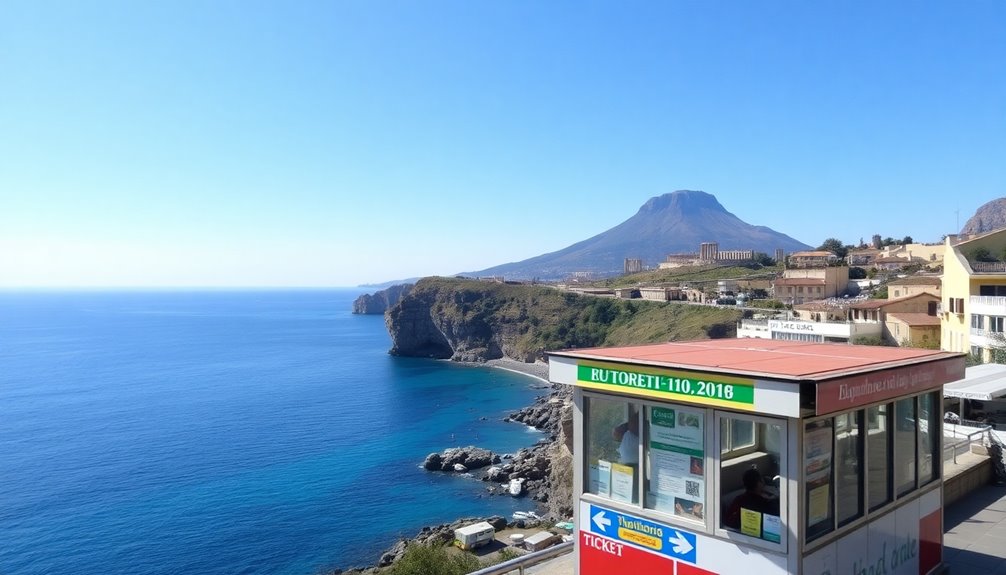
For anyone planning a visit to Pompeii, Herculaneum, or Mount Vesuvius, understanding ticket information is essential to make the most of your experience.
Pompeii tickets are priced at €18, with discounts available for students and teachers at €16. Herculaneum costs €16, with a similar discount of €14 for eligible visitors. If you're heading to Mount Vesuvius, expect to pay €20, which includes bus access and entrance to the national park from Herculaneum, or €22 from Pompeii. Additionally, exploring Pompeii with a guided tour can significantly enhance your understanding of the site's historical significance.
Children under 18 enjoy free admission to both Pompeii and Herculaneum, and EU citizens under 25 can avail of a reduced fee. It's important to note that the sites are closed on certain days, such as December 25 and January 1, so plan your visit accordingly.
For hassle-free entry, consider purchasing your tickets online; you'll receive them via email or text. Alternatively, you can buy tickets at the site entrances. To skip long lines, opt for skip-the-line tickets in advance.
If you plan to explore extensively, the MyPompeii Card offers unlimited access to all sites for €35 (€8 for those under 25). Group tickets are also available through Ticketone's call center.
Tour and Itinerary Suggestions

To make the most of your visit to Pompeii and Mount Vesuvius, a well-structured itinerary can enhance your experience significantly.
Start your day early by taking the Circumvesuviana train from Sorrento to Mount Vesuvius. Once you arrive, hop on the Vesuvio Express or Busvia del Vesuvio to reach the visitor area. Allocate about three hours for the hike to the crater and enjoy the breathtaking views.
After your morning adventure, grab lunch at one of the charming restaurants or wineries on the slopes of Vesuvius. This break will recharge you for the afternoon.
Depending on your interest, visit either Pompeii or Herculaneum next. If you choose Pompeii, set aside three to four hours to fully explore the ruins; for Herculaneum, two hours should suffice.
Tips for a Great Visit
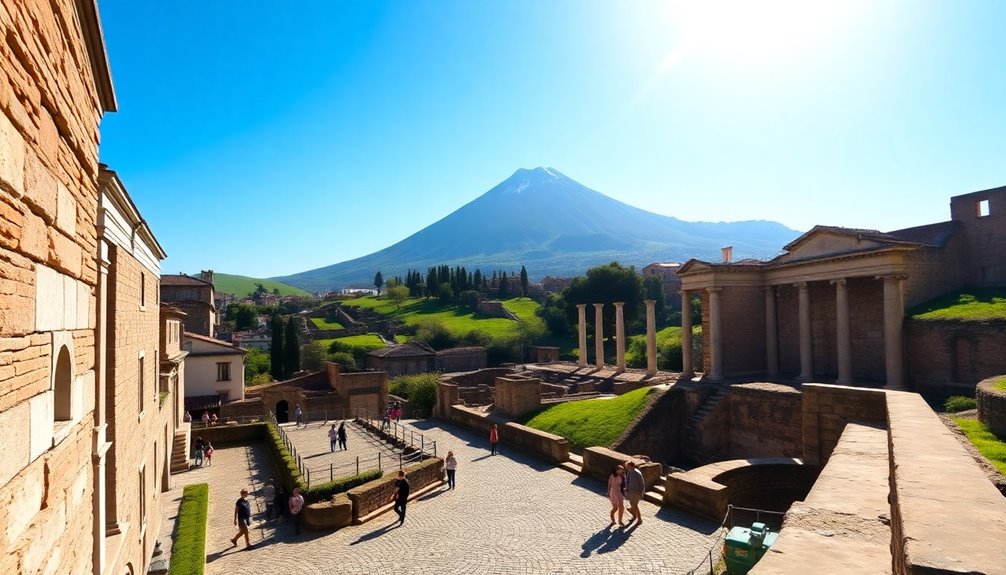
While planning your visit to Pompeii and Mount Vesuvius, being well-prepared can make a significant difference in your experience. Start by researching the historical significance of each site; it'll deepen your appreciation.
Booking skip-the-line tickets in advance can save you hours, especially in peak season. Don't forget to check the opening hours, as Herculaneum may have extended hours later in the season.
Use the Circumvesuviana train for easy transportation between Sorrento, Pompeii, and Herculaneum. Allocate enough time for each location; expect to spend 3-4 hours in the expansive Pompeii, while Herculaneum is more manageable.
Stay hydrated by bringing a refillable water bottle, and protect yourself from the sun with sunscreen and a hat. Wear comfortable, flat shoes to navigate the ancient streets.
Utilize designated entrances, and consider maps or audio guides to enhance your understanding. Remember to respect the sites, as they hold significant historical value.
If you plan to hike Mount Vesuvius, use shuttle services from the parking area to the trailhead. Lastly, follow local rules to ensure these treasures remain preserved for future visitors.
Frequently Asked Questions
What Are the Opening Hours for Pompeii and Herculaneum?
Pompeii's open daily from 9 AM to 7 PM in summer, 9 AM to 5 PM in winter. Herculaneum's hours are 8:30 AM to 7:30 PM in summer, 8:30 AM to 5 PM in winter.
Are Guided Tours Available at Both Archaeological Sites?
Yes, guided tours are available at both archaeological sites. You can choose from various languages and group sizes, ensuring you get a thorough experience of the fascinating history and attractions each site offers.
Is There Food Available Inside Pompeii and Herculaneum?
Yes, you'll find food options inside Pompeii and Herculaneum. Several cafes and snack bars offer refreshments, while nearby eateries provide meals after exploring the archaeological sites. Enjoy a taste of history and local cuisine!
Can I Bring My Dog to the Archaeological Sites?
You can bring your dog to some archaeological sites, but check specific regulations first. Small dogs are usually allowed on leashes, while larger breeds may not be permitted. Always follow local guidelines for a smooth visit.
What Is the Best Time of Year to Visit These Sites?
The best time to visit these sites is during spring or early autumn. You'll enjoy pleasant weather and fewer crowds, making your experience more enjoyable. Avoid summer for the heat and overwhelming tourist numbers.
Conclusion
Visiting Pompeii, Herculaneum, and Mount Vesuvius from Sorrento offers an unforgettable experience steeped in history and natural beauty. You'll walk through ancient streets, marvel at well-preserved ruins, and witness the stunning views from the volcano's summit. With a bit of planning, you can make the most of your trip, ensuring you don't miss any highlights. So grab your tickets, put on your walking shoes, and dive into this incredible journey through time! Prepare to be captivated by the stories of life frozen in time, as you explore the unique charm of these ancient sites. Whether you’re gazing at intricate mosaics in Pompeii or strolling through the quieter streets of Herculaneum, the experience is nothing short of magical. Don’t forget to save some energy for the trek up Mount Vesuvius, the most famous mountain in Sorrento, where breathtaking panorama views await you at the summit.
